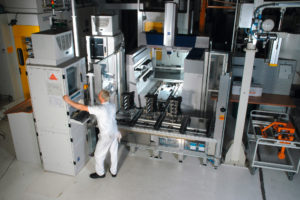OPC UA makes life easier for measurement technicians METAV 2020 showcasing the integration of length measurement technology in digitalised metalworking
The non-proprietary communication standard OPC UA (Open Platform Communications Unified Architecture) is currently experiencing rapid growth because the open platform facilitates the integration of new machines and devices into production. The VDMA is currently developing corresponding domain-specific information models (“Companion Specifications”) for length measurement technology. Trade visitors will be able to receive first-hand information from renowned measurement technology manufacturers at METAV 2020 from 10 to 13 March.

Photo: Carl Zeiss Industrielle Messtechnik
For many years, length measuring technology was kept in separate airconditioned measuring rooms and was seldom linked to other machines or software products of the factory via standardised networking. Industry 4.0 is changing that. Early measurement within the process (inline measurement) using portal measuring devices, and the communication of machine tool measurement results or correction values can optimise processes and quality assurance within the factory, and significantly increase customer productivity. As Tobias Ischen, Product Manager for Automation IT at Carl Zeiss Industrial Quality Solutions explains, “At present we generally set up closed-loop networking of this kind via file transfers and via proprietary interfaces and numerous classic protocols at the field and control level.” These solutions often only contain information on the “how”, i.e. about the technology used to transfer the data transfer. What remains unclear, however, is the “what”, i.e. what the data means: variables with semantic description. In many cases it is also highly cost-intensive to obtain this valuable (technical, documentation?) information. “With networking based on the Companion Specifications, OPC UA is the most promising solution for reducing the integration effort, at least in new production facilities. This will enable us to focus more strongly on implementing automated measurement processes and value-added metrology applications in the future because the tedious work of interface programming, including maintenance, is largely eliminated.”
METAV exhibitor Carl Zeiss Industrielle Messtechnik from Oberkochen is principally a provider of software and solutions. OPC UA will simplify networking with third-party software and platforms (Manufacturing Execution System, MES, or Cloud) and with shop floor products such as programmable logic controllers (PLCs) and peripherals such as RFID systems. “It also makes it easier for us, as an MES provider, to collect data from the customer’s machine park for OEE calculations, for example,” says Ischen. This makes production processes more transparent and opens up numerous opportunities for customers to improve the productivity, quality and profitability of their manufacturing processes. OPC UA also brings IT security to the shop floor.
Reduced costs through standards
In the context of industry 4.0, the open interface standard OPC UA represents a key technology for the non-manufacturer-dependent exchange of data. By specifying the transmission of technical data and describing the data semantics in “information models” it promotes interoperability and consequently forms the basis for technical communication based on Industry 4.0 reference architectures and implementation recommendations. “A large number of domain-specific information models, so-called OPC UA Companion Specifications, are currently being developed on the basis of the OPC UA specification,” says Dr. Armin Lechler, Deputy Director of the ISW at the University of Stuttgart. “These describe the information required within a particular domain, such as length measurement technology.” This yields advantages for both providers and users. “As with many other aspects, the purpose of standardising communication interfaces is to reduce costs. The proprietary solutions used in length measurement also result in significant amounts of engineering and adaptation work,” says Lechler. A standardised interface permits customer-specific projects to be completed more quickly. This considerably simplifies the interaction with other machines or higher-level control and planning systems. “Furthermore, an interface is not a unique selling point. All manufacturers already have this data available in one form or another – but it is not uniform,” is how Lechler sums up the current situation. “I am optimistic about future developments, given the numerous activities surrounding the Companion standards and the increasing spread of OPC UA in general. Many projects fail at present due to their implementation in industry, since the use of proprietary interfaces makes them uneconomical.”
OPC UA – reducing the numbers of rejects
“OPC UA allows us to share our knowledge from the measurement process with other process participants. This shortens response times for deviations within closed loops and saves our customers a lot of time and money,” explains Prof. Heiko Wenzel, CDO of the Wenzel Group, Wiesthal. “Besides their original application in the measuring room, our coordinate measuring machines are now increasingly being used in production. We use them to check the parts themselves, but they also give us a clear insight into production conditions such as vibration, temperature, etc., which influence our measurement results. The collection and analysis of this data is currently proprietary and can therefore only be evaluated in its own environment. Here OPC UA facilitates the sharing of information with and from other machines. This provides much faster, more accurate feedback.“ Customers benefit from the fact that the results of the analysis – aimed at achieving fewer missing parts – can flow directly into comprehensive production monitoring and control.
Wenzel will once again be showcasing its products at the upcoming METAV, the 40th anniversary of the event. The Quality Area will feature the latest developments in coordinate measuring technology, computer tomography and optical high-speed scanning. The focus will be on integration within flexible manufacturing processes and on ensuring production quality through prompt process monitoring. “Speed is currently a greater priority in standardisation than perfection. If we are not careful, standards will be put forward by other industries and regions which we will then have to follow,” says Wenzel. “We can already see that IT and automation companies – which have different focuses and expectations – are looking to position themselves here. That’s why it’s important not to pay so much attention to individual interests, but quickly to find areas of common ground – however small they may be.”
Created by daxTR